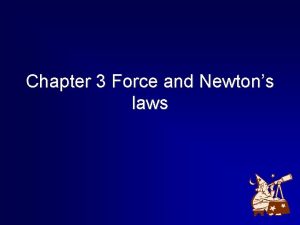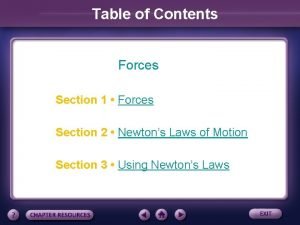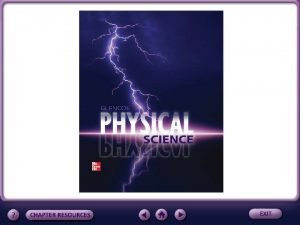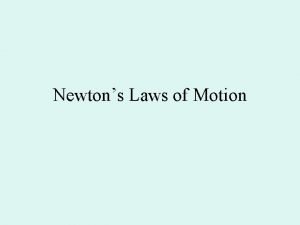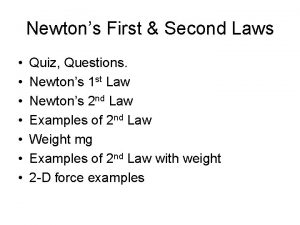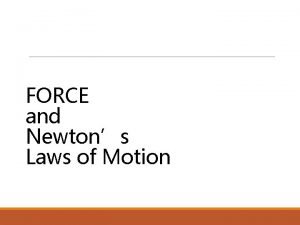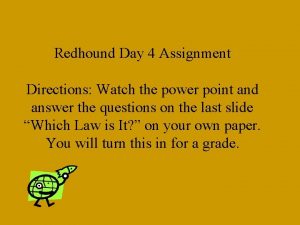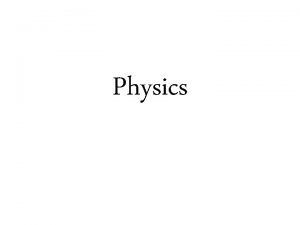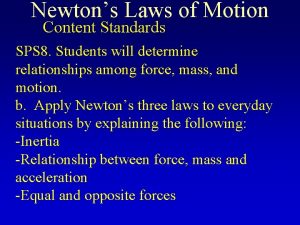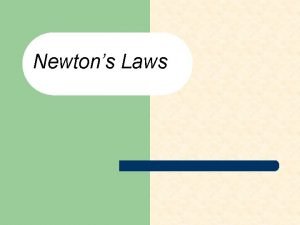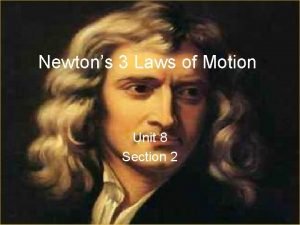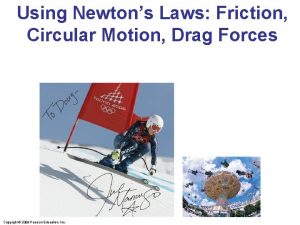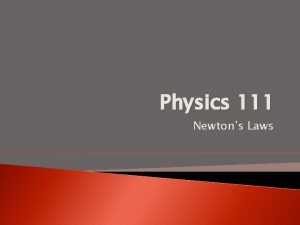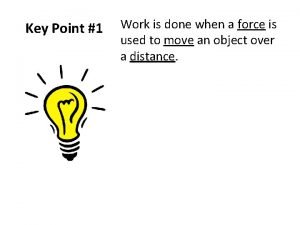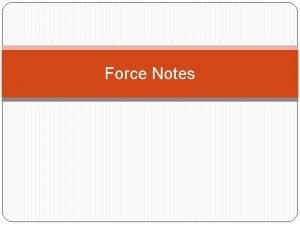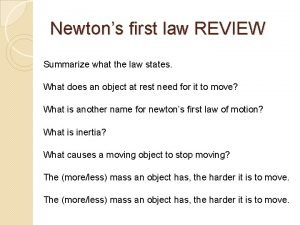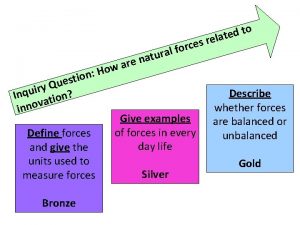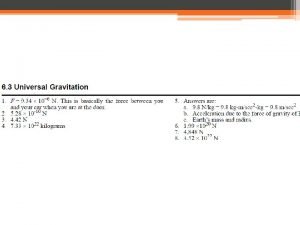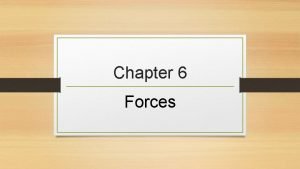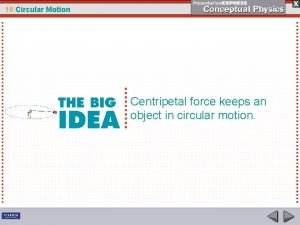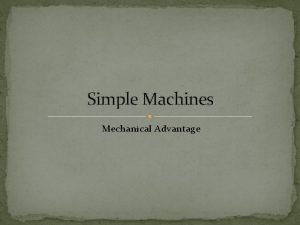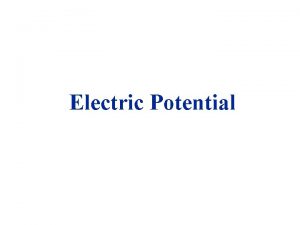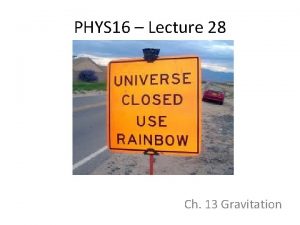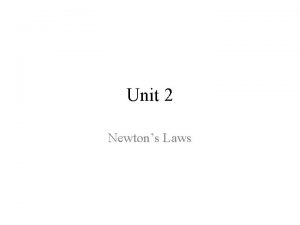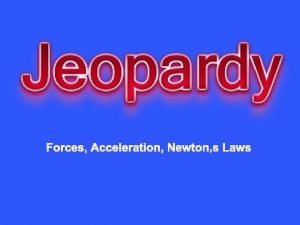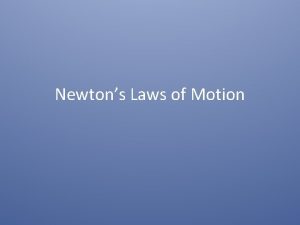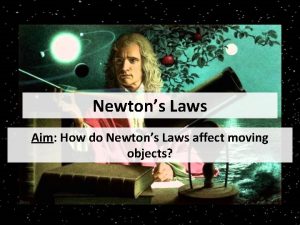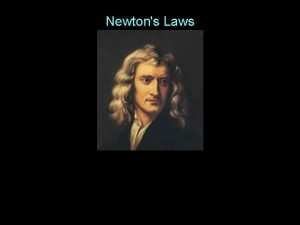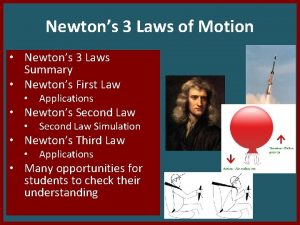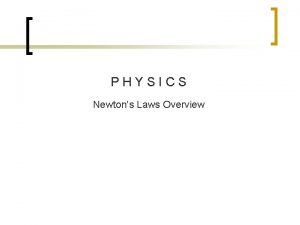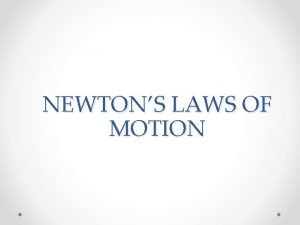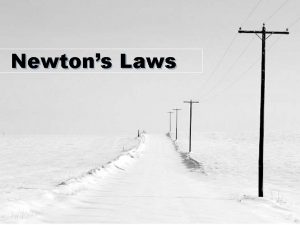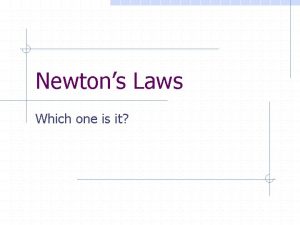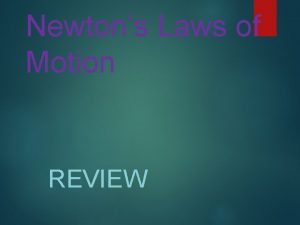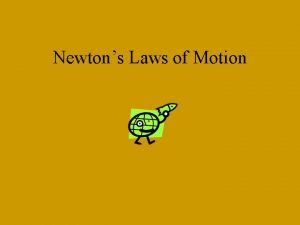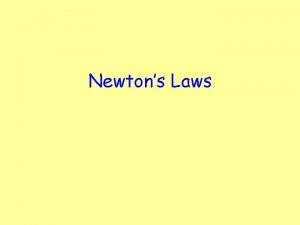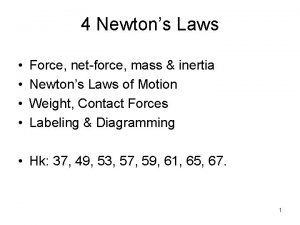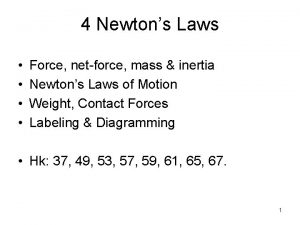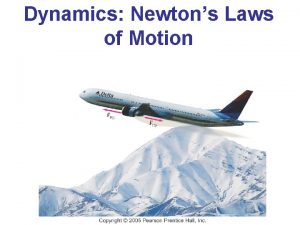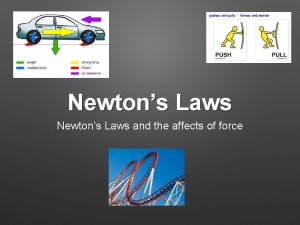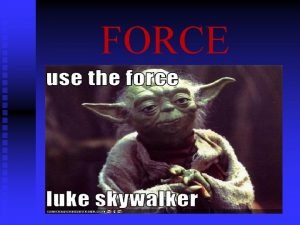Unit 9 Force Newtons Laws Newtons 3 rd







































- Slides: 39

Unit 9: Force & Newton’s Laws Newton’s 3 rd Law (action/reaction)

Forces and Interactions A force is a push or a pull. When you push on the wall, the wall pushes on you.

Forces and Interactions A hammer exerts a force on the nail and drives it into a board. • There must also be a force exerted on the hammer to stop it. • There is ALWAYS a pair of forces. (never just one force) In this case, one acting on the nail and the other acting on the hammer.

Newton’s 3 rd Law: action/reaction forces For every action force on an object, there is an equal and opposing reaction force on the OTHER object. • One force is called the action force. • The other force is the reaction force. • Neither force exists without the other. • They’re equal in strength and opposite in direction. • Do NOT cancel out (they’re on different objects)

Newton’s 3 rd Law Forces always occur in pairs. • You push against the floor, and the floor simultaneously pushes against you. • The tires of a car push against the road, and the road simultaneously pushes back on the tires. • When swimming, you push the water backward, and… the water pushes you forward.

Newton’s 3 rd Law In many cases, the interactions depend on friction as one of the forces in the pair. On ice friction is minimal and you may not be able to exert an action force against the ice. Without the action force there cannot be a reaction force, and there is no resulting forward motion.

Action and Reaction Pairs There is a simple process for treating action and reaction forces: • First identify the interaction. Let’s say one object, A, interacts with another object, B. • State the action and reaction forces in the form: Action: A exerts a force on B. Reaction: B exerts an equal force on A.

Action and Reaction Pairs Sometimes the pair of action and reaction forces in an interaction is not obvious. • In the case of a falling boulder, what are the action and reaction forces? • If we call the action Earth exerting a force on the boulder, then the reaction is… the boulder exerting a force on Earth.

Action and Reaction Pairs If action is A exerts force on B, then reaction is B exerts equal force on A.

Action and Reaction Pairs If action is A exerts force on B, then reaction is B exerts equal force on A.

Action and Reaction Pairs If action is A exerts force on B, then reaction is B exerts equal force on A.

Action and Reaction Pairs If action is A exerts force on B, then reaction is B exerts equal force on A.

Action and Reaction Pairs If action is A exerts force on B, then reaction is B exerts equal force on A.

Action and Reaction Pairs If action is A exerts force on B, then reaction is B exerts equal force on A.

Action and Reaction Pairs think! We know that Earth pulls on the moon. Does the moon also pull on Earth? yes Which pull is stronger? equal force, but opposite direction Which distance is greater—between New York and L. A. , or between L. A. and New York? The distances either way are the same. It’s the same with force pairs. Both Earth and moon pull on each other with equal and opposite forces.

Action and Reaction on Different Masses Earth is pulled up by the boulder with just as much force as the boulder is pulled down by Earth. • The forces are equal in strength and opposite in direction. Although the pair of forces between the boulder and Earth is the same, the masses are NOT equal. same F, but. . . more m, less a. Because Earth has a huge mass, we don’t sense its super tiny acceleration.

Action and Reaction on Different Masses The force a cannon exerts on a cannonball is exactly equal and opposite to the force the cannonball exerts on the cannon, but… the cannonball moves much faster than the cannon. Newton’s 2 nd Law shows that we must also consider the masses. F = ma F a= m

Action and Reaction on Different Masses The cannonball has more acceleration than the cannon because it has less mass. F = ma F a= m

Action and Reaction on Different Masses Cannon recoil from the cannonball launch can help us understand rocket propulsion. The air accelerates backward from the force of the balloon on it. The balloon accelerates forward from the force of air on it.

Action and Reaction on Different Masses Cannon recoil from the cannonball launch can help us understand rocket propulsion. A rocket accelerates as it continually recoils from the exhaust gases ejected from its engine. Each molecule of exhaust gas acts like a tiny molecular cannonball shot downward from the rocket.

Action and Reaction on Different Masses Lift Using Newton’s 3 rd Law, we can understand how a helicopter gets its lifting force. • The whirling blades force air particles downward (action). • The air forces the blades upward (reaction). • This upward reaction force is called lift. • When lift equals the weight, the helicopter hovers. When lift is greater, it climbs upward.

Quick Quiz! 1. Every interaction requires at least… A. a single force. B. a pair of forces. C. an action force. D. a reaction force.

Quick Quiz. 2. Whenever one object exerts a force on a second object, the second object exerts a force on the first object that is… A. opposite in direction and equal in magnitude. B. in the same direction and equal in magnitude. C. opposite in direction and greater in magnitude. D. in the same direction and weaker in magnitude.

Quick Quiz. 3. The force that directly propels a car along a road is that provided by the… A. engine. B. fuel. C. tires. D. road.

Quick Quiz. 4. When you jump vertically upward, what does the Earth do? A. move downward B. also move upward with you C. remain stationary D. move sideways a bit

6. 5 Defining Systems Since action and reaction forces are equal and opposite, why don’t they cancel to zero? To answer this question, we must consider the system involved.

Defining Systems The system (orange) accelerates from force. The action force ON orange (from apple) is not cancelled by the reaction force ON apple. The orange still accelerates. system force reaction force ON orange ON apple

Defining Systems a. Action and Reaction forces cancel b/c… IN system NOT ON system

Defining Systems a. Action and Reaction forces cancel b/c… IN system NOT ON system b. apple pushes on floor, so floor pushes on apple The orangeapple system accelerates. system force ON orange-apple system

Defining Systems Inside a baseball, trillions of atomic/molecular forces hold the ball together but do not accelerate the ball. They are part of action-reaction pairs within the ball, but they combine to zero. If the action-reaction forces are internal to the system, then they cancel and the system does not accelerate. An external force, such as a swinging bat is needed to accelerate the ball.

Defining Systems think! Suppose a friend who hears about Newton’s 3 rd Law says that you can’t move a football by kicking it because the reaction force by the kicked ball would be equal and opposite to your kicking force. The net force would be zero, so no matter how hard you kick, the ball won’t move! What do you say to your friend? If you kick a football, it will accelerate b/c no other force has been applied to the ball. (the ball applies a reaction force to your foot, not a cancelling force on the ball)

The Horse-Cart Problem Will the horse’s pull on the cart be canceled by the opposite and equal pull by the cart on the horse, thus making acceleration impossible? IN system ON ground ON system

The Horse-Cart Problem 3 pairs of forces: P/P F/F f/f IN system: P forward – P backward (cancels) ON system: F forward – f backward IN system ON ground ON system

The Horse-Cart Problem ON system: F forward – f backward F = F – f = Fnet a= Fnet mcart+horse IN system ON ground ON system

6. 6 The Horse-Cart Problem Turn to p. 81 in your book NOW!

Action Equals Reaction If you hit the wall, it will hit you equally hard. You cannot touch without being touched. How hard can you hit a piece of paper in the air? You can only be apply a force that can be applied back to you.

Quick Quiz! 1. A system undergoes acceleration only when acted on by a(n)… A. net force. B. pair of forces. C. action and reaction forces. D. internal interactions.

Quick Quiz. 2. If a net force acts on a horse while it is pulling a wagon, the horse… A. accelerates. B. is restrained. C. is pulled backward by an equal and opposite net force. D. cannot move.

Quick Quiz. 3. At a pizza shop, the cook throws the pizza dough in the air. The amount of force the cook exerts on the dough depends on the… A. mass of the dough. B. strength of the cook. C. weight of the dough. D. height of the cook. The cook can only exert a force on the dough that is equal to what the dough can exert back on him.
 What are the laws of motion
What are the laws of motion Newton's law of gravitation
Newton's law of gravitation Newton's 3 laws
Newton's 3 laws Newtons laws of gravity
Newtons laws of gravity Section 3 using newton's laws
Section 3 using newton's laws Section 3 using newtons laws
Section 3 using newtons laws Elevator bank
Elevator bank Colin skateboards down the sidewalk
Colin skateboards down the sidewalk Find the mass of a football player who weighs 1250 n
Find the mass of a football player who weighs 1250 n What are newtons 3 laws
What are newtons 3 laws Newton's first and second law quiz
Newton's first and second law quiz Newton's 3rd law example
Newton's 3rd law example Newton's three laws
Newton's three laws Law of newton
Law of newton The three laws of motion
The three laws of motion Newtons laws
Newtons laws Newton unit
Newton unit 3 laws of motion names
3 laws of motion names Newtons laws
Newtons laws 3 laws of newton
3 laws of newton Newton's first law of motion examples
Newton's first law of motion examples Newtons laws
Newtons laws Ethan is dragging a bag of grass
Ethan is dragging a bag of grass Charles de secondat
Charles de secondat The baseball player does 1234 joules of work
The baseball player does 1234 joules of work A force of 25 newtons east
A force of 25 newtons east What the law
What the law Acceleration
Acceleration A person lifts a 950 n box by pushing it up an incline
A person lifts a 950 n box by pushing it up an incline Unit 10, unit 10 review tests, unit 10 general test
Unit 10, unit 10 review tests, unit 10 general test Non-contact forces portfolio
Non-contact forces portfolio What force provides centripetal force
What force provides centripetal force Long range force
Long range force If you whirl a tin can on the end of a string
If you whirl a tin can on the end of a string How does mechanical advantage work
How does mechanical advantage work Force what is force
Force what is force Centrifugal forces in rwanda
Centrifugal forces in rwanda Is air resistance a non contact force
Is air resistance a non contact force Is electric force a conservative force
Is electric force a conservative force Centripetal force and gravitational force
Centripetal force and gravitational force




